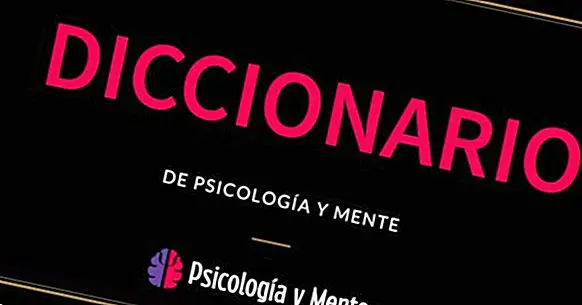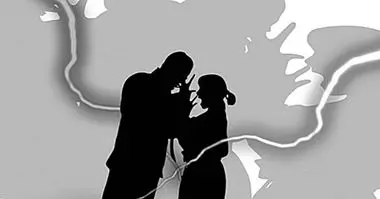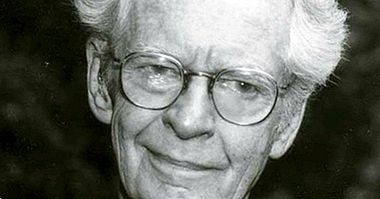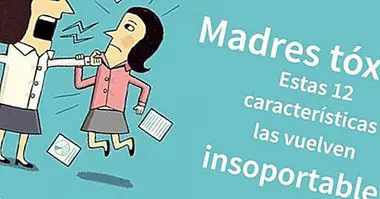Dictionary of Psychology: 200 fundamental concepts
For a freshman Psychology student, the concepts and terms used during the exercise of the profession of psychologist may sound strange . There are many authors who, over more than two centuries of life, have been cementing the knowledge of what we know today as the science of behavior and mental processes.
Thus, psychologists and experimenters have been constructing a series of new words that are part of the slang of mental health professionals. Concepts that have even come to be used not only by therapists but also in common language.
Psychological dictionary: from A to Z
In this article we are going to review over 200 terms, theories, disorders and authors that you should know if you are going to be a psychologist or psychologist. From a to Z.
TO
Abulia
It refers to the presence of impotence and lack of will to act in order to fulfill a desired objective. It can be considered the highest degree of apathy.
Attitude
Tendency to act or think in a certain way with respect to a specific phenomenon, situation or stimulus, derived from the experience or the transmission of concrete points of view regarding said reality.
Aerophobia
Phobia or pathological and irrational fear of flying by plane.
Aphasia
Difficulty or absence of the ability to communicate effectively orally. These are language disorders caused by damage to the brain areas linked to this ability. It can affect aspects such as verbal fluency, comprehension, imitation or articulation.
Agnosia
Failure or alteration in the recognition of some type of stimulation. The stimulus is perceived through the senses, but a part or concrete aspect of the stimulus is not recognized or the totality of the stimulus. It can occur in any sensory modality.
Agoraphobia
Phobia or irrational and high intensity fear to be or stay in places or situations where it is not possible or complicated to escape or receive help in case of need, such as places that gather a large number of people. It is usually identified with the fear of open spaces, although it is not limited to it.
Alog
Impoverishment and slowness of thought. Alteration of the ability to formulate logical and connected thoughts, as well as to construct a coherent discourse. The presence of blockages is frequent.
Hallucination
Perceptive deception in which a stimulus is perceived that does not exist in the external environment, generally being convinced by the subject that perceives it of its truthfulness. They can be of any sensory modality and be linked or not to certain stimuli.
Negative hallucination
Perceptual deception in which the subject is not able to perceive a stimulus that does exist in the real world. For example, he is not able to detect his image in a mirror. In spite of this, in many cases the behavior is altered as if the individual was aware of the existence of the stimulus in question.
Antegrade amnesia
Inability to code and record new information in memory.
Retrograde amnesia
Inability to remember past events, of greater or lesser severity.
Dissociative amnesia
Amnesia of psychic origin caused by the experience of a traumatic or highly stressful event. It is a retrograde amnesia, generally circumscribed to the autobiographical.
Analgesia
Absence or temporary elimination of the ability to perceive pain.
Anesthesia
Absence or temporary elimination of sensory perception. It can refer to the type of product used to produce it.
Anhedonia
Absence or diminished presence of the capacity to feel joy or pleasure, even before stimulations previously considered as pleasurable.
Anorexy
Loss of appetite, which can be caused by very different circumstances
Anorexia nervosa
Disorder characterized by the rejection of the sufferer to maintain a minimum body weight, presenting fear of gaining weight and maintaining an alteration of the perception of one's own body image. In order to reduce weight, people eat less or stop eating enough quantities, resorting in some cases to compensatory behaviors such as provoking vomit or strict diets. A restrictive and a purgative subtype can be found.
Anxiety
State of discomfort or emotional suffering in anticipation of possible aversive stimulation in the future, which generates cognitive, physiological and behavioral reactions.
Ansiolitic
Substance with psychoactive effects capable of helping to regulate, manage or eliminate a state of anxiety or anguish.
Antidepressant
Substance with psychoactive effects whose action is capable of combating states of emotional distress such as those of depressive states.
Apathy
Lack of motivation to act, absence or diminished presence of interest.
Apraxia
Difficulty or absence of the ability to perform and coordinate sequenced movements.
Aprosexia
Maximum degree of decrease in attention capacity. Absence of attention and the ability to mobilize it.
Fitness
Ability to effectively and skillfully perform a certain type of action.
Asthenia
Absence of energy Fatigue and weakness that makes it difficult to carry out activities.
Self-confidence
According to Albert Bandura's theory, self-confidence refers to the perception of one's own ability to achieve certain objectives and carry out various actions successfully. Also known as self-efficacy.
Selfconcept
Set of thoughts and beliefs about the self that each individual has. It is the concept or image that each one has of himself.
Self esteem
It is a term used in psychology to designate the consideration and esteem that each individual professes towards his own person. It is about the valuation that a person makes of himself based on his self-concept.
Self instructions
Set of internal vocalizations directed to oneself that are used to guide one's behavior through sequences of instructions.
B
Bandura, Albert

Albert Bandura is one of the most influential and recognized psychologists, having been president of the American Psychological Association. His most well-known studies configure the Theory of Social Learning. For this author the behavior can be modified and replicated through the observation of behavioral models and their subsequent imitation.
Barbiturate
Type of substance derived from barbituric acid that is used mainly as hypnotic and sedative. Before the arrival of benzodiazepines, they were the type of drugs most used in the fight against anxiety and sleep disorders. Their therapeutic and toxic doses are very close and easily generate dependence, the overdose being relatively simple to achieve and being able to cause the death of the subject.
Benzodiazepines
Type of substance traditionally used as anxiolytic. They act mainly through the potentiation of gamma-aminobutyric acid, which reduces the level of activation of the brain. They are also used in the treatment of insomnia and other problems.
Bipolarity
Bipolar disorder is a mood disorder characterized by an alteration between manic and depressive states. It can be type one, in which at least one manic episode has happened, or type two in which there has been no manic episode but a hypomanic episode and one or more depressive episodes.
Bradipsiquia
Slowing down of thought
Bulimia nervosa
Eating disorder characterized by the presence of binge eating in which the control of the intake is lost, followed by feelings of guilt and compensatory behaviors carried out in order not to gain weight, such as the provocation of vomiting. The self-evaluation is sensitively linked to the appreciation of the body figure. It can be purgative or non-purging.
C
Catatonia
Disorder characterized by lack of mobility, waxy flexibility, opposition and negativism, ecosymptoms, mannerisms, perseveration, rigidity, silence and stupor.
Brain
Organ located inside the skull, central element of the nervous system of most animals and especially vertebrates. Its main function is the direction and management of the set of systems that make up the organization. Although the upper part of the brain, the cortex, is technically referred to as the brain, this term is generally referred to the encephalon as a whole.
Cyclothimia
Mood disorder characterized by the presence of changes in mood between depression (without it meets the criteria to diagnose major depression) and hypomanic euphoria, persistent continuously for at least two years. These fluctuations and symptoms are lower than those of bipolar disorders, and this can not be diagnosed.
Cognitivism
Paradigm of psychology focused on understanding and studying the cognitive processes that govern and regulate human behavior based on a scientific methodology based on reason.
Coma
Deeper state of loss of consciousness, in which the subject does not respond to any type of stimulation and which is due to an injury or serious impairment of brain function. Despite this, there is brain activity, so that the person is still alive even though they may need breathing and artificial life support. The forecast is very variable depending on what caused this state.
Behavior
Way of acting in front of a certain situation. It is often used as a synonym for behavior.
Compulsion
A ritualized act that is carried out for the purpose of relieving the anxiety generated by a particular thought or act. Its realization does not suppose a resolution of the problem, but in fact it feeds it back, so that the subject tends to repeat it in order to produce a temporary relief.
Conduct
Any act or action performed by an agency, usually intentionally and voluntarily.
Behaviorism
One of the main paradigms of psychology. It is based on the premise of focusing research exclusively on empirical data demonstrable through experience, using the scientific method. It mainly analyzes the only directly observable correlate of the psyche, behavior. This is explained by the capture of the properties of the stimuli and the emission of the responses to them, as well as the association between stimuli and responses. It can be modified through learning, either from the stimulation itself or from the reinforcement or punishment of behaviors.
Counter-transference
Projection of a set of feelings, reactions and emotions by the therapist about his patient, generated based on the existing link in the therapeutic relationship.
Convulsion
Violent, abrupt and involuntary contractions of the musculature, generally generated by an alteration of brain activity. It is one of the most visible and known symptoms of epileptic seizures.
Cerebral cortex
Set of nervous tissue that forms the most external and superior part of the brain and that allows the analysis and integration of different information from the environment, as well as the acquisition and realization of different skills and abilities such as speech, abstract thinking, intelligence or the ability to regulate behavior.
Coulrophobia
Phobia or irrational fear of clowns, of unknown cause.
Craving
Anxiety and anguish felt by a subject due to a strong desire to consume a substance.
Hard body
Structure composed mainly the axons of a large number of neurons, which keeps the two cerebral hemispheres interconnected and allows the transmission and integration of information from both.
D
Delirium
Alteration of the content of thought. It presents a particular idea or belief that is experienced as real and is characterized by being of great intensity, irrational and resistant to change despite evidence contrary to it.
Delirium
State of altered level of consciousness of variable severity, sudden onset and short duration that causes a decrease in intellectual abilities and the presence of possible alterations in attention, memory, speech, perception and motor skills. Its origin is in a disease, intoxication or sensory deprivation
Delirium tremens
Acute and potentially fatal confusional syndrome resulting from abrupt cessation of alcohol consumption in people with alcohol dependence. It is one of the most serious and dangerous forms of withdrawal syndrome. Alterations in the level of consciousness, visual hallucinations, febrile states, seizures, stupor and emotional lability are frequent.
Dementia
Neurodegenerative disorder, usually of biological origin, which presents with a progressive deterioration of different cognitive abilities such as memory, speech, sequencing of movements or the ability to reason. It differs from delirium in the progressive deterioration in mental capacities and the absence of alterations of consciousness.
Depression
Mood disorder characterized by a sad and / or irritable mood, the presence of anhedonia and other symptoms such as hopelessness, feeling of helplessness, decreased attention span, and perception of reality from a negative perspective in what it refers to the world, to themselves and to the future itself.
Derailment
Language pattern in which there is no common thread in the discourse. There is a loss of associations, building unconnected sentences and putting them together without apparent meaning.
Depersonalization
Sensation of not being in one's own body, feeling the body and one's mind as something strange.
Displacement
Defense mechanism based on the person projects in a situation, stimulus or person the feelings and reactions that have caused other situations, stimuli or people, without there being a link between both elements.
Derealization
Sensation of unreality with respect to what is lived. The things, the surroundings and / or the situations are perceived as strange and unreal.
Intellectual disability
Presence of more or less severe limitations in the interaction and adaptation to the environment due to the presence of an intellectual capacity lower than that expected by age and level of maturational development of the subject.
Dyskinesia
Neurological disorder that generates involuntary and uncontrolled movements, usually in the facial muscles.
Dislalia
Speech disorder in which there are difficulties in the articulation of phonemes, generating substitutions of one phoneme by another, distortions, additions or even omissions.
Dysphemia
Also called stuttering, refers to the disorder of speech fluency in which the subject suffers a blockage in the form of spasm that prevents or interrupts the formation of words. It is often accompanied by shame and avoidance to speak in public.
Dissociation
Alteration of the mental capacities that supposes a partial or total rupture between different aspects of the psyche, having a separation between the integrated self and some of the different aspects or capacities of the mind. It is frequent in the face of traumatic events. Concrete examples may be dissociative amnesia or multiple personality disorder.
Dispaurenia
Presence of pain during the performance of the sexual act, subsequently to it or even prior to it. It can cause an avoidance of relationships not only sexual but also affective
Dysthymia
Mood disorder characterized by a low positive affect and a low level of energy that occur continuously over time. A sad state of mind is maintained for at least two years almost daily, with frequent increase or loss of appetite, sleep problems, low self-esteem and feelings of hopelessness and helplessness, although of a severity less than that of a depression.
Drug
Substance that when introduced in the organism can alter one or several functions of this one. If we talk about psychoactive substances, drugs are characterized by producing alterations in brain functioning and can cause sensations satisfactory to the consumer, although its prolonged consumption tends to make the body get used to them and generate tolerance.
AND
Ellis, Albert

Cognitive psychologist of great importance worldwide. Creator of Rational Emotive Therapy, which considered that emotional states are generated by the interpretation of the phenomena that we live. Therefore, it is necessary to provoke a change in this interpretation if a change in the emotional state of the patient is to be achieved.
Empathy
Ability to perceive, detect and share a person's mood and / or perspective, knowing how to put themselves in their place.
Erythrophobia
Phobia or intense and irrational fear of blushing in public and that others notice it. Linked to the fear of being judged by others.
Ergofobia
Pathological and irrational fear or phobia to appear at one's workplace. It does not necessarily prevent the inability to maintain an occupation, but it makes it difficult. The causes can be multiple.
Perceptive excision
Disintegration and separation into different elements of aspects of the same stimulus, which are captured separately. For example, sound and image, or color and shape, are separately captured.
Schizophrenia
Psychotic disorder characterized by the presence of positive symptoms such as hallucinations and delusions and / or negatives such as impoverishment and alteration of language, difficulties in maintaining attention. One of the most well-known symptoms is the presence of hallucinations, usually auditory. There are several subtypes.
Stereotypy
Realization of certain movements, postures or emission of sounds in a repetitive or ritualized form without a specific purpose.
Stress
State of intense physiological activation that aims to act as a mechanism to face a threatening situation. If it is prolonged over time it can generate fatigue and exhaustion due to the wear caused by the continued use of energy resources both physically and mentally.
Stupor
State of alteration of consciousness that is very complex to leave, requiring a very powerful stimulation for it. It is usually accompanied by immobility and the absence of voluntary movement.
Eutimia
Emotional state considered normative, without major alterations and relatively stable.
Exhibitionism
Paraphilia characterized by the presence of persistent sexual fantasies and the performance of acts consisting of exhibiting the genitals in public before unknown persons, being the observation of the surprise or the reaction of others the reason for the excitement of the subject.
Exposition
Type of therapy that is based on the confrontation of the patient with what he fears or causes anxiety, in order to be able to cope with it and progressively reduce the level of fear it causes. Usually it is used based on a hierarchy according to what supposes greater or less level of anxiety to the patient, advancing in a more or less gradual way.
Extraversion
Personality trait that is characterized by the focus on the outside world, there being a tendency to relate to others and to interact with the environment.
F
Fetish
Tendency to the presence of recurrent sexual fantasies linked to the use of non-animated objects. that causes discomfort or deterioration in some vital area of the subject that suffers it. It is a type of paraphilia.
Filia
Taste, preference or liking to certain situations or stimuli, to which one tends to approach. It is considered the opposite of phobia.
Filofobia
Phobia to fall in love Fear of emotional bonding, in many cases derived from the fear of abandonment or humiliation.
Phobia
Irrational, disproportionate and high intensity fear to a specific stimulus or situation that provokes the behavioral avoidance (or avoidance) of the stimulus. The feared stimulus generates anxiety and anguish. The existence of a phobia can cause an alteration in the habitual life of the individual who suffers it.
Freud, Sigmund

Father of psychoanalysis. This Viennese doctor established psychoanalysis as a method of studying behavior, explaining the psyche and treating mental problems. He focused his theory on the presence of conflicts between different psychic structures and the repression of unconscious instincts and instincts. He considered that psyche was fundamentally directed by the sexual drive or libido, elaborating different theories regarding mental functioning and psychosexual development.
Frotteurismo
Paraphilia characterized by the continued presence of fantasies and sexual impulses linked to the idea of rubbing against unknown people and against their will, impulses that either have been carried out or generate discomfort in the subject.
H
Heminegligence
Disorder caused by alterations and neurological injuries in which the affected has severe difficulties or is unable to capture half of the hemifield, not being aware of part of their perception and unable to orient, respond or act on the opposite side to the brain injury .
I
Delusion
Perception or distorted interpretation of an existing stimulus although ambiguous.
Influence
The ability of one subject to alter the behavior or thinking of another.
Introversion
Personality trait characterized by the focus on the inner world and the mental processes themselves, requiring less activation from the environment.
L
Control locus
Perception by the individual of the causality of the different phenomena that happen to him. The subject attributes the successes and failures to different types of causes, which may be stable or unstable, global or particular, internal or external. This attribution is linked to the attitude that each person takes in the face of different events and even relates to a great extent to self-concept and self-esteem.
Leadership
Ability to guide and direct the behavior of other people towards a specific objective, being able to manage the actions of other people, establishing objectives and motivating towards their achievement.
Gambling
Disorder characterized by the presence of uncontrolled impulse and the need to play different types of games of chance. The subject is unable to resist the impulse, using it as a method to combat the discomfort and producing an addiction that alters the vital functioning of the subject and his environment.
M
Mania
State of mind expansive and highly activated, with acceleration of thought and speech, high impulsivity that can lead to irritability and hostility. Characteristic of the consumption of certain substances or disorders such as bipolar.
Modeling
Type of therapy based on delayed learning in which one or several subjects act as models recreating a certain situation, so that the patient observes how to perform certain actions or behaviors to be able later to carry them out. There are many types of modeling depending on the type of model, the level of participation of the subject or the means used.
Molding
Method by which one tries to achieve the establishment of a determined behavior through the realization of behaviors more and more approximated to the desired, establishing intermediate steps to achieve it that will be reinforced.
N
Neuron
Type of cell that forms the basic unit of the nervous system, whose interconnection allows the transmission of electrochemical impulses through the organism in order to be able to manage the different systems that configure it.
Neuroticism
Psychological trait that refers to the level of stability or emotional instability of an individual. Neurotic subjects have a labile emotionality, characterized by elevated levels of anxiety, and tension and the rapid change from a positive emotional state to a negative one.
OR
Obesity
State of altered consciousness in which it is difficult to capture the attention of the individual, being continuously distracted and may be perceptual alterations. The subject is disoriented and confused if he is removed from this state.
Obsession
Repetitive and uncontrolled thought that appears spontaneously in the mind and proceeds to repeat itself insistently, being perceived as inadequate and highly distressing. This thought is lived as one's own despite not being controlled, and usually tries to avoid it through various mechanisms. It is the main core of obsessive-compulsive disorder.
P
Paraphilia
Presence of persistent fantasies of an excitatory nature towards atypical desire objects that usually include non-human or non-consenting subjects, objects, or pain, which produce discomfort and suffering and affect the habitual functioning of the person suffering from it or of third parties.
Pareidolia
Perceptual phenomenon through which the person perceives a recognizable pattern or shape to ambiguous or ill-defined stimuli, such as shapes in the clouds or perceiving the shape of a face in smoke or spots on a wall. It is not something pathological.
Pedophilia
Subtype of paraphilia in which the subject of sexual attraction of a subject is a minor child, having the subject at least sixteen years of age and being at least five years older than the object of desires.
Projection
Defense mechanism in which the subject identifies own characteristics in other individuals, collectives, objects or entities.
Pseudociesis
Also known as psychological pregnancy. It is a type of dissociative disorder that causes the symptoms of a pregnancy without it actually occurring.
Psi
Symbol commonly related to psychology.
Psychoanalytical
Substance with activating psychoactive effects, which cause an increase or acceleration of the nervous system.
Psychoanalysis
Paradigm of psychology centered on the unconscious and the existence of conflicts between the instincts and their external expression. It focuses largely on the deep part of the psyche and its analysis, working with symbolic elements. Likewise, it also focuses on past experiences of patients, especially those that have occurred throughout the development. Psychoanalysis is considered a theoretical framework, a research technique and a therapeutic method.
Psychodysleptic
Substance with psychoactive effects that generates an alteration in the functioning of the nervous system, producing different consequences and being able to alter perception.
Psychogenic
It refers to something whose origin or cause is psychological and not organic.
Psychoptic
Type of depressant substance, which causes a deceleration or decrease in the activity of the nervous system.
Psychopath
Individual characterized by lack of empathy, superficial charm, low responsibility and cordiality and difficulties in establishing long-term goals, giving priority to the immediate satisfaction of one's needs even at the expense of others. They usually present a low level of obedience to authority and present antisocial behavior.
Psychotic, disorder
Type of disorder characterized by the presence of a rupture or mismatch of the psyche with reality, observing unusual behaviors and being frequent the presence of hallucinations and delusions.
R
Rapport
Level of harmony between two or more people, generally referring to the relationship between patient and therapist. It is necessary that rapport be positive in order to establish a good therapeutic relationship.
Feature
Characteristic of the consistent person through different situations and that remains stable over time. It is an element that allows establishing a tendency to be, see the world or act in a certain way.
Regression
Concept of psychoanalytic origin that refers to the return to a phase of previous development as a defense mechanism against stressful events.
Repression
Main defense mechanism, consisting in the eradication of mental contents that are unacceptable for the subject.
Resilience
Ability to deal with traumatic situations in an adaptive way, coming out stronger from said situations.
Role
Role or function assigned to a person in a given situation. It supposes a series of expectations regarding the behavior of the person to whom it has been assigned with the role in question.
S
Sadism
Paraphilia characterized by excitement or obtaining pleasure from the causation of pain or humiliation to another person.
Sign
Element directly observable for an external observer. It is an objective element that can serve as a reliable indicator of the existence of a disorder or problem.
Synapses
Point of interconnection between two or more neurons. It is an intermediate space in which the emission and reuptake of the various neurotransmitters occurs.
Synesthesia
Agglutination of sensations of different modalities in the same perception. Two types of perceptions are merged and perceived together. Before a sound it is possible to perceive a color or before an image to hear a sound, for example.
Symptom
Sign or indication of a subjective nature of an abnormal or pathological state. Must be referred by the subject to be detected, not being directly observable.
Positive symptoms
Type of symptoms that are added to the habitual functioning of the subject. Examples of this may be hallucinations, delusions or disorganized behavior. Typical of schizophrenia and psychotic disorders.
Negative symptoms
Set of symptoms that cause a decrease in the usual abilities already existing in a subject. For example, affective blunting or alloy. They usually have a worse response to treatment than positive symptoms and can cause long-term deterioration.
Somatization
Unconscious and involuntary process by which a subject physically and physiologically manifests psychological problems.
T
Taquipsiquia
Acceleration of thought. He often attends with the inability to follow a thread of thought to its conclusion.
Night terrors
Sleep disorders that occur during the fourth phase of non-REM sleep, specifically in the deep sleep phase. It is a dreamlike projection that causes a deep sense of dread in the subject, the subject can sit up, scream or shake. During this episode the subject can be difficult to wake up. After the episode the person does not have any kind of memory regarding what happened.
Transfer
Process by which a patient projects a set of feelings, emotions and reactions on his therapist, which suppose the evocation of previous links that lead to a new object.
W
Wundt, Wilhelm

Founder of experimental psychology, creator of the first laboratory of psychology and father of psychology as a science (before it was considered part of philosophy). He founded structuralism. In his beginnings he studied sensations and aspects like the speed of reaction to the stimuli. He considered that there should be a differentiation between the objective and the subjective aspects of behavior, with the introspection capacity for analyzing subjective processes having great importance for him.
Z
Zoophilia
Paraphilia which consists in the sexual attraction by non-human animals, giving this in a consistent and continuous way in time and being able to consummate or not said attraction.
Bibliographic references:
- Myers, David G. (2005). Psychology. Mexico: Panamericana Medical.
- Triglia, Adrián; Regader, Bertrand; García-Allen, Jonathan. (2016). Psychologically speaking. Paidós.
- Tubert, Silvia. (2000). Sigmund Freud: Fundamentals of psychoanalysis. Argentina: EDAF.



















